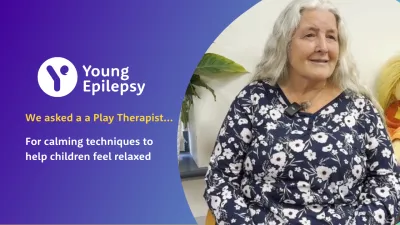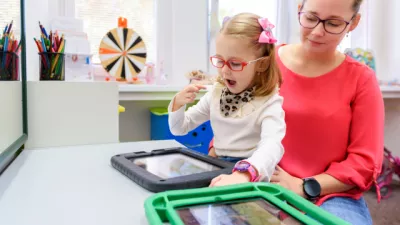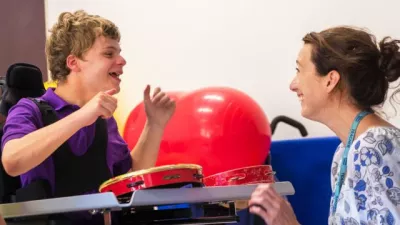Play is an essential part of every child’s development, offering opportunities for learning, creativity and social growth. For children with epilepsy, play can also serve as a powerful tool to encourage positive behaviour, build resilience and foster self-confidence.
By engaging in play, parents can help their children navigate the unique challenges of epilepsy whilst celebrating their individuality and strengths.
This page covers different approaches to play to help empower parents with insights and strategies to harness the benefits of play which can provide your child with lessons and tools to thrive in their personal development.

Why does play matter?
Play is an important part of a person’s development. It lies at the heart of learning to communicate and making sense of the world around us. Through play children can explore their creativity, enhance their problem-solving skills and build emotional resilience.
Play offers a safe space to navigate challenges, develop a sense of accomplishment, and connect with others.
Children with epilepsy may experience developmental delays in areas such as motor skills, cognitive abilities, or social interactions. Play can be particularly beneficial in addressing these challenges, as it provides a natural and enjoyable way for children to practice essential skills in a supportive environment.
By encouraging play that is adapted to the child's individual needs, parents can help nurture their child’s growth ensuring they experience the same joy as their peers.
Children who receive a diagnosis of epilepsy later in their childhood may still experience developmental delays, particularly before the age of 11, and can benefit enormously from play, which can help them come to terms with their condition.

Play and personal and social development
Play is a vital component of personal and social development. Through play children gain a sense of control over their environment, which can be especially empowering when managing the uncertainties of their condition. It offers a safe space to explore their feelings and experiences, helping to process emotions in a constructive way.
Through play, they can take back some ownership of their life, explore their own feelings and their reactions to their condition and experiences.
Play builds confidence and self-esteem, as children succeed in their creative pursuits, games and puzzles for example, while allowing children to explore themselves and the world around them.
It enables children to practice their reactions and responses to various situations.
Furthermore, positive and rewarding, play experiences support learning and self-development by nurturing creativity and problem-solving skills, and reinforcing the three cornerstones of social development:
- Social interaction
- Social communication
- Social understanding the imagination
The stages of play
As children develop, they go through several stages or types of play:
- Intensive interaction
- Non-directive play
- Directive play
- Imaginative play
- Games with rules
- Positive redirection
Read more about all of these below.
Intensive interaction
Intensive Interaction is based on the kind of interactions between mother and baby when your baby is just starting to develop communication skills.
It’s a really useful way of developing communication skills when your child is at the pre-verbal stage – not yet able to speak properly and using vocalisations, gestures and even eye movements to communicate.
In intensive interaction:
-Your child is in control
-You respond to your child’s body language and facial expressions
-The play is interactive
-The play can be used to develop turn-taking behaviour
-Turn-taking is important. It’s one of the first things to develop in a relationship and is important because it establishes the idea of interacting with another person.
-This reduces your baby’s sense of isolation, which can otherwise lead to high levels of frustration.
-Communication is the key to reducing that frustration.
Body language is very important during intensive interaction, as your child will be learning a lot about themselves through your responses.
You’ll need to:
- Share their attention
- Mirror their vocalisations
- Mirror their actions
- Mirror their facial expressions
- Develop tension – possibly through tickling games, where your baby develops anticipation, understanding that something will happen before it happens.
During the first 12 months, your child learns to control their emotions by having their emotions reflected back at them.
Once they’ve learnt this, they’ll be better able to understand and cope with their own and other people’s emotions.
This very important piece of learning will be with them for life.
You can reflect back positive emotions and encourage your child to enjoy being in this state.
Take care, though, with excitement, as it can get out of hand if allowed to mount.
It’s important to distinguish between emotions such as excitement, joy and amusement, and emotions such as anger, fear, frustration and aggression.
Anger, fear, frustration and aggression are legitimate emotions that need to be handled carefully. Your child needs to learn to recognise and handle them.
You can help them do this by naming these emotions and showing respect for them, and then helping them to move on.
Be empathic – show that you understand and care. Give your child time and space to process their feelings.
But try not to let your child to dwell on these negative emotions.
Make soothing sounds and motions. Try to introduce a new activity to distract them from what’s upset them.
When your child’s behaviour becomes more uninhibited, it can rise to a level where it becomes inappropriate and leads to conflict.
They may no longer be in control of themselves. Their behaviour might annoy other people. They may even hurt themselves or someone else.
So, try to calm them using slow-down movements and slow-down sounds.

Non-directive play
Non-directive play, also known as child-centred play, is where children play and adults are allowed to join in.
Non-directive play is a soothing activity where your child is completely free to play however they want, choosing the items they want to play with.
This type of play is important for your child to make sense of their world.
You support your child in their play, without giving any signs of approval or disapproval, and allow them to take the lead and control how the play develops.
This type of play is suitable for two-year-olds and above. Children are usually verbal at this point and there’ll be some pretend play.
Non-directive play can be hard for children with developmental delay, who may not be able to take part in imaginative or conceptual play.
Children who struggle with non-directive play may prefer puzzles, matching games and construction games.
Although these might seem fairly solitary activities, you can make them more interactive by playing the game with your child and introducing turn-taking.
Try to vary the activities to avoid repetition, boredom and overdependency on a few chosen activities.
Directive play
You can use directive play to help develop your child’s social understanding and imagination.
Directive play involves a variety of techniques, including modelling, joining in and being used as a human tool.
This is where you do something and hope your child copies you.
The success of modelling depends on whether your child is interested in the activity and wants to do it themselves.
So, first, do the activity yourself and then hand it over or offer it to them.
Be positive and encourage them to take part in the activity. Praise your child in a meaningful and appropriate way.
Wait for your child to start something and then join in what they’re doing so they learn how to take control and understand what the consequences can be.
Allow your child to use you as a tool. This can help them to develop the confidence to try something while also reducing their fear of the unknown.
They’ll be happy to use your hand to touch or do something and then watch your reaction before they try it for themselves.
Sometimes, a child will want to take your hand and make you do what they want, but they’re too afraid to try.
After a while, when you’ve repeated actions a few times, you can slowly withdraw your hand or support as your child starts to do it for themselves.
Avoid hand-over-hand activities where you’re guiding the child, as that won’t encourage them to take part.
If your child lacks confidence or has developmental coordination disorder (DCD), also known as dyspraxia, they may find it hard to control their movements.
So, use your hand to support theirs, but let them make the decisions.
Imaginative play
Children move on to imaginative or symbolic play to understand what’s happening around them.
They play out their experiences, often repeatedly, until they can accept and understand their world.
Often, children don’t have the vocabulary or communication skills to express themselves and explore their feelings, so they use play instead.
For children trying to come to terms with their epilepsy, it may help to use hospital sets, doctors/nurses outfits, stethoscopes, etc to let them play out their experiences.
Battery-operated and vibrating toys can help children to understand what happens during a seizure.
Don’t be alarmed by this sort of play. It’s natural and all part of a child coming to terms with what’s happened to them.
If this sort of play continues repeatedly for a long time, then it might be helpful to see a play therapist to help your child work though their issues.

Games with rules
When children can, they will start to play games with rules, which are useful for helping to cope with losing and disappointment.
Play develops confidence and self-esteem, so allow children with low confidence or self-esteem issues to win enough to feel confident, but lose occasionally.
Children can only accept defeat when their confidence levels are high.
Card games and scrabble are the kind of games where you can appear to lose without making it obvious to your child.
Positive redirection
The key here is redirecting your child’s feelings in a positive way. Positive redirection is useful for dealing with challenging behaviour.
Here are some examples:
| Challenging behaviour | Try... |
|---|---|
| They want to kick you | Going outside to kick a ball |
| They want to throw things | Throwing something harmless, e.g. a balloon, pom-pom, balls into a bucket or playing basketball |
| Loud noises | Pacifying, calming down |
| Shouting | Play a shouting game |
| Swearing | Ignoring, because this is done to get a response |

Keep it varied, make the time
If you can, have a variety of toys and equipment available for your child, including:
- Sensory play things, e.g. rattles, soft puzzle mats, shake and spin balls, rubber balls, soft baby books
- Construction toys, e.g. Lego, Meccano, Mega Bloks, Magna-Tiles, etc.
- Cause and effect toys, e.g. push and pop toys, pop-up toys, sound blocks, sound puzzles, jack/frog in a box, car ramp racers
- Pretend play resources, dressing-up outfits, train sets, cars, soldiers, dolls
- Role-play equipment, e.g. shopping, cleaning, cooking, tea sets, tool bench, cash register, playing doctor, playing police, etc.
- Turn-taking games, e.g. talking stick, conversation ball, conversation role-play, conversation video, continuing the story, team drawing, Mr Potato, magnetic face puzzle, building a tower, etc.
Most importantly, make time to play.
Time to process
Sometimes, children just aren’t interested in play and may need time, space and permission to do nothing.
You may be able to play at a low level, e.g. play going to sleep and waking up.
But, there will be times when your child simply needs to be by themselves to process events and understand what has happened to them.







